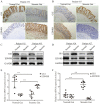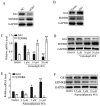Gli family zinc finger 1 is associated with endothelin receptor type B in Hirschsprung disease
- PMID: 29484400
- PMCID: PMC5866029
- DOI: 10.3892/mmr.2018.8612
Gli family zinc finger 1 is associated with endothelin receptor type B in Hirschsprung disease
Abstract
Hirschsprung disease (HSCR) is a newborn colorectal disease characterized by an absence of ganglia in the distal gut. Hedgehog (Hh) and endothelin signaling serve important roles in gastrointestinal tract formation. Alterations in the signaling pathways disrupt the development of enteric neural crest cells (ENCCs). It is not known whether there is any coordination between these pathways in the pathogenesis of HSCR. In the present study, tissue samples from 35 patients with HSCR, including stenotic aganglionosis gut and normal ganglionic gut, were obtained. The expression of Gli family zinc finger 1 (Gli1) and endothelin receptor type B (EDNRB) was determined using reverse transcription‑quantitative polymerase chain reaction, immunohistochemistry and western blotting. In addition, the SK‑N‑SH cell line was used to investigate the association between Hh signaling and the expression of EDNRB. The results revealed aberrant expression of Gli1 in the aganglionic segments, as well as decreased expression of Gli1 in tissues from 7 patients with HSCR exhibited, whereas tissues from 9 patients with HSCR exhibited increased Gli1 expression compared with the expression in the normal tissues. There was a negative association between EDNRB expression and Gli1 expression in the same sample. Knockdown of Gli1 by small interfering RNA and inhibition of Hh signaling by Vismodegib in SK‑N‑SH cells increased EDNRB expression. By contrast, upregulation of Gli1 expression by plasmids and activation of Hh signaling by Purmorphamine decreased EDNRB expression. Furthermore, premature enteric ganglia were observed in 4 patients with HSCR with decreased Gli1 expression. Thus, the results of the present study suggest that altered Gli1 expression negatively regulates EDNRB expression in patients with HSCR. The increased expression of EDNRB induced by decreased Gli1 expression may represent a novel mechanism in HSCR.
Keywords: Hirschsprung disease; hedgehog signaling pathway; endothelin receptor type B; enteric neural crest cells.
Figures



Similar articles
-
Methylation analysis of EDNRB in human colon tissues of Hirschsprung's disease.Pediatr Surg Int. 2013 Jul;29(7):683-8. doi: 10.1007/s00383-013-3308-6. Epub 2013 Apr 12. Pediatr Surg Int. 2013. PMID: 23579558
-
B-lymphocyte-intrinsic and -extrinsic defects in secretory immunoglobulin A production in the neural crest-conditional deletion of endothelin receptor B model of Hirschsprung-associated enterocolitis.FASEB J. 2019 Jun;33(6):7615-7624. doi: 10.1096/fj.201801913R. Epub 2019 Mar 25. FASEB J. 2019. PMID: 30908942 Free PMC article.
-
Interactions between Sox10 and EdnrB modulate penetrance and severity of aganglionosis in the Sox10Dom mouse model of Hirschsprung disease.Hum Mol Genet. 2004 Oct 1;13(19):2289-301. doi: 10.1093/hmg/ddh243. Epub 2004 Aug 4. Hum Mol Genet. 2004. PMID: 15294878
-
EDNRB/EDN3 and Hirschsprung disease type II.Pigment Cell Res. 2001 Jun;14(3):161-9. doi: 10.1034/j.1600-0749.2001.140305.x. Pigment Cell Res. 2001. PMID: 11434563 Review.
-
Roles of Enteric Neural Stem Cell Niche and Enteric Nervous System Development in Hirschsprung Disease.Int J Mol Sci. 2021 Sep 7;22(18):9659. doi: 10.3390/ijms22189659. Int J Mol Sci. 2021. PMID: 34575824 Free PMC article. Review.
References
MeSH terms
Substances
LinkOut - more resources
Full Text Sources
Other Literature Sources

